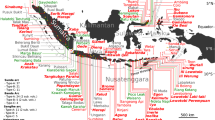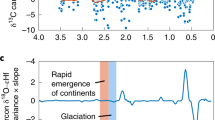Abstract
Arising from F. Gaillard, B. Scaillet & N. T. Arndt Nature 478, 229–232(2011)10.1038/nature10460
Around 2.5 billion years ago, Earth’s atmosphere turned from anoxic to oxic in what is known as the Great Oxidation Event. Gaillard et al.1 suggest that this oxygenation was caused by the emergence of the continents and a shift in volcanism from predominantly submarine to primarily subaerial conditions. Because the ratio of volcanic SO2 to H2S in their model increases with this shift, they argue that the atmosphere became more oxidized. But their model also predicts that outgassing of CO2 decreases at the lower pressure of continental volcanism, and that this should act against atmospheric oxygenation because CO2 is the substrate for the production of oxygen from photosynthesis. Hence, their mechanism may not trigger a rise in atmospheric O2.
Similar content being viewed by others
Main
There are three problems to consider. First, Gaillard et al.1 argue that the release of SO2 comes at the expense of H2S, according to:

But the extra H2 released by this reaction exactly compensates for the switch from H2S to SO2. The mixture of SO2 and H2 has the same redox potential as H2S and water2. Fortunately, what happens in their model is different. The H2S to SO2 ratio is buffered by magma, which has a fixed oxidation state, described in terms of a fixed oxygen fugacity. The relevant reaction is:

where ‘O2’ represents oxidants (mostly ferric iron) in the melt. Reaction (2) produces SO2 and H2 in equimolar proportions, in agreement with results shown in figure 2 of ref. 1. When SO2 is reduced to pyrite, FeS2, it consumes hydrogen as follows:

Because reaction (3) consumes more hydrogen per mole of SO2 than is produced by reaction (2), the net effect is to oxidize the atmosphere. Thus, this part of their proposed atmospheric oxidation mechanism appears to work, but not for the reasons they stated.
The second issue is that sulphur-containing gas fluxes are not the only ones that control O2. CO2 is crucial because some CO2 is reduced to organic carbon, CH2O, which is then buried. A mole of photosynthetic O2 is released for every mole of buried CH2O. However, O2 can be lost in atmospheric reaction with H2, so the net effect is:

The carbon isotope record suggests that ∼20% of outgassed CO2 is reduced and buried in this manner3,4. Holland4 quantified the effect of volcanic gases on the hydrogen budget by defining a parameter denoted f. Gases for which f > 1 can reduce 20% of the CO2 to organic matter and all of the SO2 to pyrite, leaving excess hydrogen to support an anoxic atmosphere; gases with f < 1 contain too little hydrogen to do this. Atmospheric O2 ‘wins’ over hydrogen when f drops below unity. This analysis neglects other sources of hydrogen that might have been important (for example, serpentinization of ultramafic rocks on the continents and seafloor, or precipitation of ferric iron in banded iron formations), but it is useful for analysing the volcanic gases of ref. 1.
In the model of Gaillard et al.1, the proportion of CO2 in released volcanic gases decreases by a factor of ∼3 when volcanoes switch from submarine to subaerial conditions because the pressure decreases from 100 bar to 1 bar. This change should tend to oppose atmospheric oxygenation, as less organic matter is buried (given a constant burial fraction), and thus less H2 is consumed. To estimate the net effect on atmospheric redox balance, we calculated f values for cases listed in the Supplementary Information of ref. 1. Gaillard et al.1 include S2 as a species, which requires us to modify Holland’s f parameter, as follows:

Here, m(i) is the mole fraction of species i in the released gases. As shown in Table 1, f is less than unity in the cases shown in Supplementary Tables 1 and 2 of Gaillard et al.1, and so would not allow a reduced atmosphere before 2.4 Gyr ago. This means that no rise of O2 is possible because the initial atmosphere is already oxidized. This could be because other hydrogen sources are neglected, as mentioned above, or because model parameters—for example, the outgassing temperature—are incorrect. In any case, the model, as presented in ref. 1, appears incapable of triggering a rise in atmospheric oxygen if Holland’s method of analysis is correct.
Last, Gaillard et al.1 assume that gases released from a submarine magma at 1,300 °C do not re-equilibrate with the surrounding basalts at lower temperatures as they emerge from depth; this assumption is at odds with previous work5,6. Such re-equilibration might have allowed Archaean volcanic gases to be more reduced; hence, a switch to subaerial volcanism around 2.5 Gyr ago might then result in atmospheric oxidation. But this would be a different oxidation mechanism from the one described in ref. 1. There is also a broader caveat. The reduced oxidation state of volcanic gases comes at the expense of oxidizing the source rocks; thus, erosion and subsequent reduction of the source rocks may cancel out surficial redox change in the long term.
References
Gaillard, F., Scaillet, B. & Arndt, N. T. Atmospheric oxygenation caused by a change in volcanic degassing pressure. Nature 478, 229–232 (2011)
Kasting, J. F. & Brown, L. L. in The Molecular Origins of Life: Assembling the Pieces of the Puzzle (ed. Brack, A.) 35–56 (Cambridge Univ. Press, 1998)
Hayes, J. M. & Waldbauer, J. R. The carbon cycle and associated redox processes through time, Phil. Trans. R. Soc. Lond. B 361, 931–950 (2006)
Holland, H. D. Volcanic gases, black smokers, and the Great Oxidation Event. Geochim. Cosmochim. Acta 66, 3811–3826 (2002)
Kump, L. R. & Seyfried, W. E. Hydrothermal Fe fluxes during the Precambrian: effect of low oceanic sulfate concentrations and low hydrostatic pressure on the composition of black smokers. Earth Planet. Sci. Lett. 235, 654–662 (2005)
Kump, L. R. & Barley, M. E. Increased subaerial volcanism and the rise of atmospheric oxygen 2.5 billion years ago. Nature 448, 1033–1036 (2007)
Author information
Authors and Affiliations
Contributions
All three authors contributed equally to this Comment.
Corresponding author
Ethics declarations
Competing interests
Competing Financial Interests Declared none.
Rights and permissions
About this article
Cite this article
Kasting, J., Catling, D. & Zahnle, K. Atmospheric oxygenation and volcanism. Nature 487, E1 (2012). https://doi.org/10.1038/nature11274
Received:
Accepted:
Published:
Issue Date:
DOI: https://doi.org/10.1038/nature11274
This article is cited by
-
Unexpected Thiocyanate Adsorption onto Ferrihydrite Under Prebiotic Chemistry Conditions
Origins of Life and Evolution of Biospheres (2020)
-
Sulfur and oxygen isotope insights into sulfur cycling in shallow-sea hydrothermal vents, Milos, Greece
Geochemical Transactions (2014)
-
Gaillard et al. reply
Nature (2012)
Comments
By submitting a comment you agree to abide by our Terms and Community Guidelines. If you find something abusive or that does not comply with our terms or guidelines please flag it as inappropriate.



